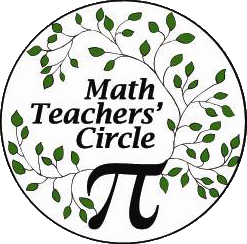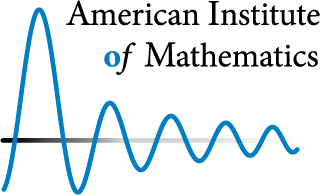
Locked Out
A breakout box session for your Circle
Kimberly D. Adams and Donna S. Farrior
Like the MTCircular? Subscribe to our free semi-annual magazine.
Math Wrangles and Math Auctions are well-known math circle activities in which teams compete for the best solutions of a set of engaging and challenging problems. The Tulsa MTC has used these formats to great success in previous meetings. Outside the math circle arena, Escape Rooms and “Bomb Disposal” activities are growing in popularity as a form of team building and entertainment.
This fall, we blended the two ideas to create a cooperative math activity where the challenge is to solve math problems whose solutions generate combinations to open a locked box. The math problems can be selected to fit any audience, and the activity appeals to problem solvers of all ages.
Materials
- Lockable box
- Hasp
- A variety of combination locks
- Handout with problems
- Handout with lock instructions
We used six locks per box: several three- and four-digit combination locks, a directional lock, and a word lock. Breakout Kits may be purchased directly from BreakoutEDU, but we built our own kits at around $40 per kit. If you can afford it, we recommend making one kit for every six to eight participants.
A word to the wise: Keep up with the combinations, as the locks are the most expensive part of the kit. (Remember losing your locker combination in junior high?) We made a one-page master set of instructions for opening all the locks in our kits.
So, what’s in the box? Maybe a letter to the participants, or some small prizes. Maybe another locked box with one additional puzzle. It doesn’t really matter! The anticipation of solving puzzles, the fun of working together, and the reward of opening the box can outweigh any physical prizes.
Preparing for the Session
The beauty of the Breakout Box session is that the problems can be tailored to your group, and can change every time you do it. For a fun teacher session, you can choose to do one challenging problem per lock, or a few easier problems. Here are our suggestions for picking problems:
- Include problems from a variety of topics: geometry, counting, number theory, logic, etc.
- Use problems with multiple entry points. More entry points = more opportunities for teamwork.
- Avoid problems where the solution can be guessed from a small finite set, such as a Knights and Liars problem: “Who was lying? Tom or Joe?”
- Once you have selected your problems, consider eliminating two or three so as to not overwhelm the participants.
Suitable problems may be found in student math contests as well as magazines and puzzle columns. A small list of suggested problems and resources can be found in the Resources list below.

When designing your session, keep in mind that you can tack on instructions for creating a combination from the results. For example, say that four problems have solutions 27, 15, 45 and 120. To create a combination for a directional lock, you might ask participants to convert each solution to its mod 4 equivalent (3, 3, 1, 0) and then assign a direction to each result (0=up, 1=down, 2=left, 3=right) to produce the combination right, right, down, up.
We cannot stress it enough: triple-check your materials and handouts before the session begins. It is very frustrating for participants if we have made an error in the calculation to a combination lock!
The Session
As participants arrive, place them in groups of six to eight. Late arrivals can form a new team, or join an existing team. Give each group a set of the lock instructions and the problem list, and tell them the time limit. Then start the clock running!
Participants will become aware that brute force methods are not an efficient use of their time. Rather, these problems require creativity and productive work. You may be called upon to verify the correctness of a solution on the spot if a lock won’t open.
When the first team opens its first lock, the excitement in the room starts to build. Depending on how competitive your group is, you can relax the rules towards the end of the session, and allow teams to help each other. During our session, one team had only one lock remaining at the end, and another team helped them find the combination.

Takeaways
One of the biggest challenges with this activity is time management. A normal Math Teachers’ Circle session can be shortened or lengthened on the fly. However, the timing of a Breakout Session is set the moment you distribute the materials.
At our first Breakout Session, no team actually opened their box in the allotted 90 minutes without help. Surprisingly, this was not an issue. The excitement of opening each lock kept the groups energized and productively working throughout the session. Opening a single lock is a big victory!
Resources
- Handout with suggested problems
- Handout with lock instructions
- Sources of good problems for a breakout box session:
- Vaderlind, Paul, et al. The Inquisitive Problem Solver. The Mathematical Association of America, 2002.
- Erickson, Martin. AHA! Solutions. The Mathematical Association of America, 2009.
- Johnson, Ken, et al. Crossing the River with Dogs. Wiley, 2012.
- Chen, Sam, et al. AMC 8 Preparation. Self-published, 2014.
- The Art of Problem Solving, AMC Problems and Solutions.
- Math Kangaroo, Sample Problems
- Brilliant.org
- Games Magazine
This article originally appeared in the Spring 2018 MTCircular.
 |
 |
Kimberly Adams is an Instructor and Donna Farrior a retired Instructor in the Mathematics department of The University of Tulsa. Both authors are co-directors of the Tulsa Girls’ Math Circle, and are members and occasional facilitators at the Tulsa Math Teachers’ Circle. |
MORE FROM THE
SPRING 2018 MTCIRCULAR

|
Touching InfinityHyperbinary numbers and fraction trees
|

|
Listen, Share, PlayLessons from preschool for problem solving
|

|
Tiling with PentagonsExploring newly discovered math
|

|
Bolognese Wins Statewide Teaching AwardColumbus MTC leader was recognized by the Ohio Council of Teachers of Mathematics
|
 |
Finkel, Jones Present at International ConferencesTwo MTC leaders present in Australia and Colombia
|

|
Shubin Honored with Mary P. Dolciani AwardMTC Network leader honored for bringing Math Circles to new communities
|

|
Engle, Danforth-Clayson Win Rosenthal PrizeBay Area MTC members win national math curriculum writing contest
|
 |
A Note from AIMA commitment to ourselves, our students, and each other
|
 |
OpportunitiesSpecial events, recognitions, careers
|
 |
Dispatches from the CirclesLocal updates from across the country
|

|
Global Math Week“Exploding Dots” from coast to coast
|

